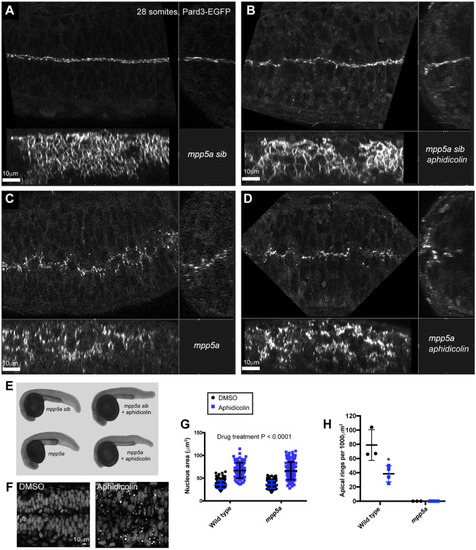
Mpp5a is necessary for apical ring formation even in the absence of cell division. All embryos are at the 28-somite stage. (A-D) Orthogonal series of horizontal (top left), transverse (top right) and sagittal (bottom) confocal planes of Pard-EGFP expression in the following embryos. (A) Wild-type sibling treated with DMSO vehicle control. Many small apical rings have formed at the tissue midline (n=3/3 embryos). (B) Wild-type sibling treated with aphidicolin to block the C-divisions. Fewer, large apical rings have formed at the tissue midline (n=4/4 embryos). (C) mpp5am227 mutant embryo treated with DMSO vehicle control. No apical rings have formed at the tissue midline. Pard3 is visible as spots along the midline plane (n=3/3 embryos). (D) mpp5am227 mutant embryo treated with aphidicolin to block C-divisions. No apical rings have formed at the tissue midline. Pard3 is visible as spots along the midline plane (n=4/4 embryos). (E) Overall body shape of wild-type siblings and mpp5am227 mutants with and without aphidicolin treatment. (F) Horizontal section through neural tube showing nuclear staining in wild-type embryos treated with DMSO or aphidicolin to block C-divisions. Aphidicolin-treated embryos have larger nuclei, demonstrating that S-phase division block was successful. (G) Quantification of the area of the nucleus of wild-type siblings and mpp5am227 mutants with and without aphidicolin treatment. Data from 100-150 nuclei were pooled from two or three embryos in each group and analysed by two-way ANOVA. Areas of aphidicolin-treated nuclei were, on average, 30 µm2 bigger than those of DMSO-treated embryos (P<0.0001). There was no significant difference in the area of nuclei between wild-type and mpp5am227 mutant embryos (P=0.8561). Error bars denote standard deviations. (H) Quantification of the number of apical rings in wild-type siblings and mpp5am227 mutants with and without aphidicolin treatment. Numbers of apical rings per 1000 µm2 were calculated from three or four embryos per group. No apical rings were seen in any of the mpp5am227 mutants. There were, on average, 40 fewer apical rings per 1000 µm2 in aphidicolin-treated wild-type embryos than in DMSO-treated wild-type embryos (Student's unpaired t-test, P=0.0222). Error bars denote standard deviations.
|